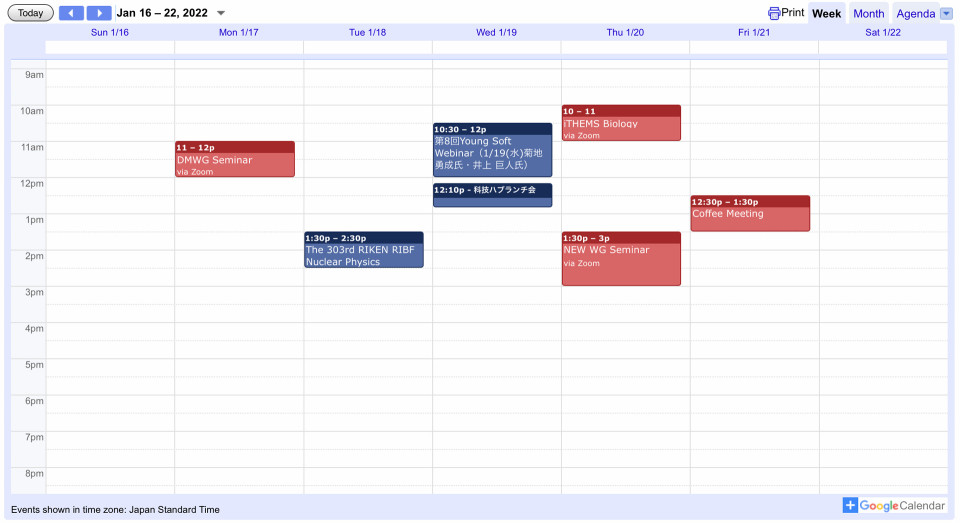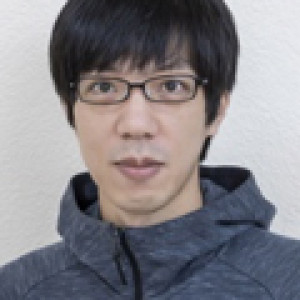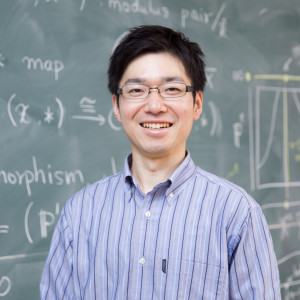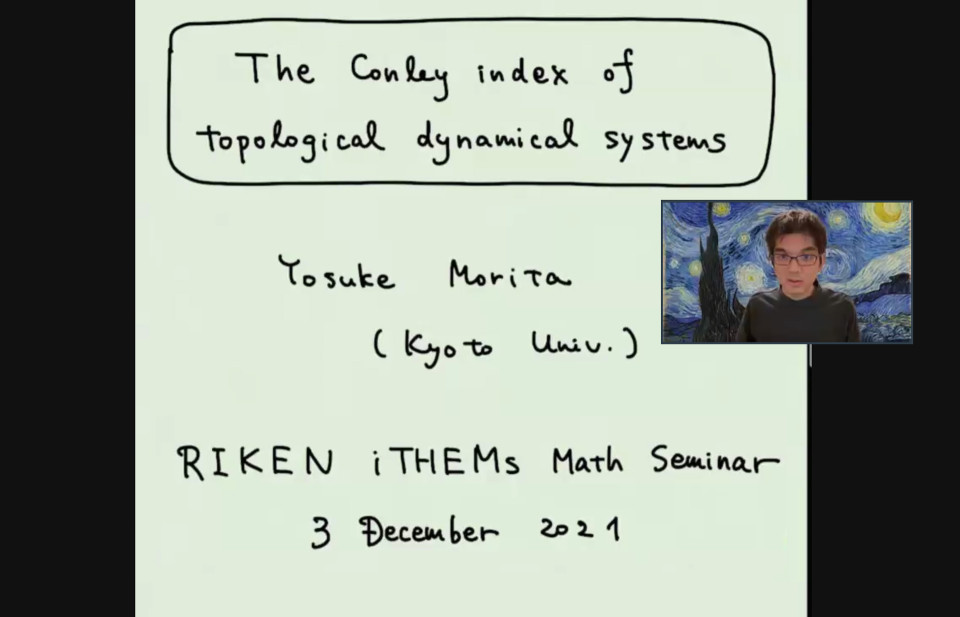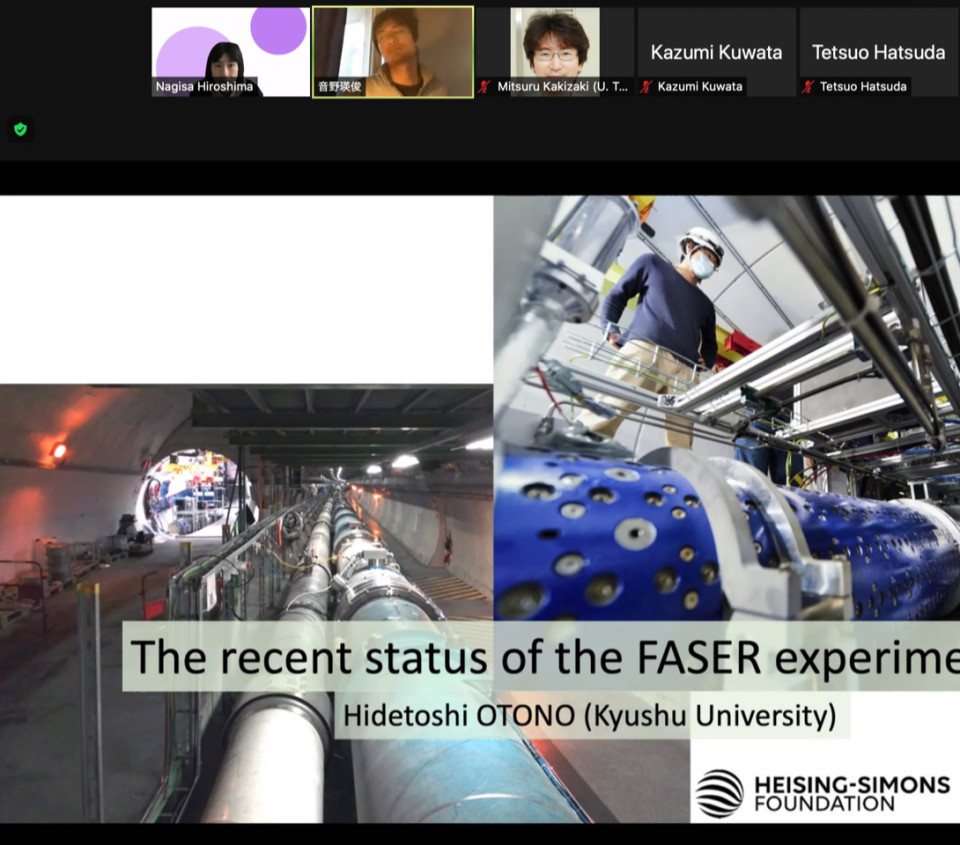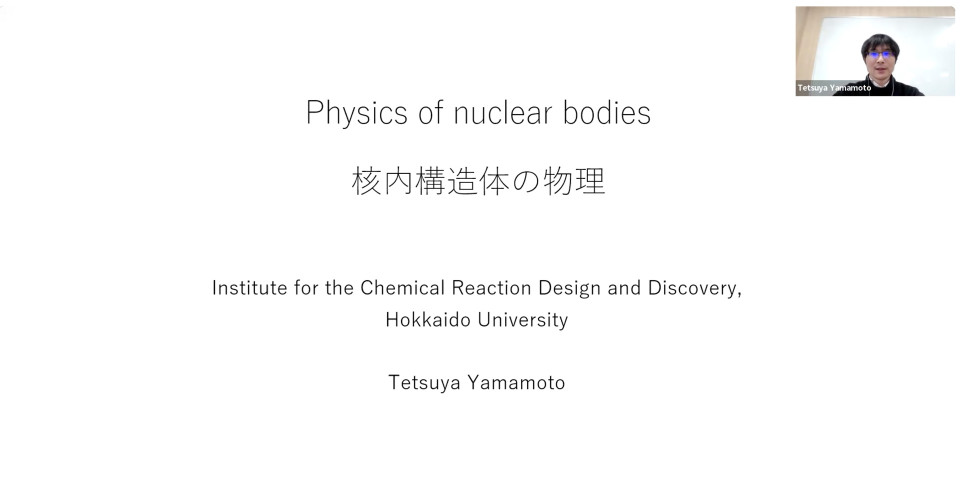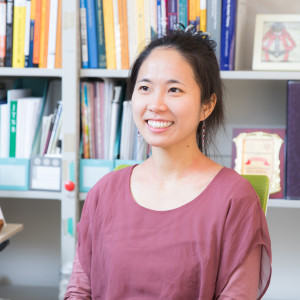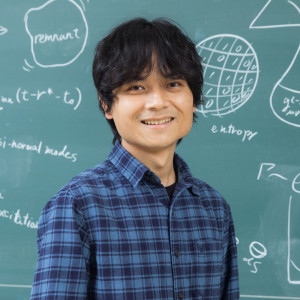Volume 181
Back to Newsletter List
Event Schedule
Events for the 4th week of January 2022
2022-01-13
Monday, January 17, 11:00– 12:00 DMWG Seminar
Thursday, January 20, 10:00– 11:00 iTHEMS Biology Seminar
Thursday, January 20, 13:30– 15:00 NEW WG Seminar
Friday, January 21, 12:30- Coffee Meeting
Press Release
Simplifying Complex Chemical Reaction Networks - a reduction method using homological algebra
2021-12-27
A team of researchers, Yuji Hirono (Visiting Scientist, iTHEMS), Takashi Okada (Senior Research Scientist, iTHEMS), Hiroyasu Miyazaki (Senior Research Scientist, iTHEMS) and Yoshimasa Hidaka (Visiting Scientist, iTHEMS), has developed a new method for simplifying complex chemical reaction networks using a mathematical technique called “homological algebra”. Using this method, complex networks can be simplified while preserving their important features and their properties can be studied more efficiently. The research is conducted by a team of physicists, a mathematician, and a biologist, and demonstrates the effectiveness of a cross-disciplinary approach.
To read more, please see the related link.
Reference
- Yuji Hirono, Takashi Okada, Hiroyasu Miyazaki, and Yoshimasa Hidaka, Structural reduction of chemical reaction networks based on topology, Phys. Rev. Research 3, 043123 (2021), doi: 10.1103/PhysRevResearch.3.043123
Seminar Report
iTHEMS Math Seminar by Prof. Yosuke Morita on December 3, 2021
2021-12-28
On December 3, Yosuke Morita from Kyoto university gave a talk titled “The Conley index of topological dynamical systems” at the iTHEMS math seminar. He reviewed the fundamental concepts of study of topological dynamical systems and introduced the notion of index neighborhood which is used to define his refined Conley index. His talk contained many instructive examples which enable us to understand his talk easily. Finally, his refined Conley index is defined as a functor into a category of (equivariant) condensed sets. This gives new conceptual understanding of Conley index in terms of condensed set introduced by Clausen and Scholze recently. His talk was very interesting and stimulated many questions and discussions. I believe it was a very worthwhile time for many participants.
Reported by Masaki Taniguchi
The Conley index of topological dynamical systems
December 3 (Fri) 16:00 - 18:00, 2021
Seminar Report
DMWG Seminar by Prof. Hidetoshi Otono on December 15, 2021
2021-12-28
Among kinds of approaches for dark matter (DM), collider experiments are advantageous in their high precision. The FASER (ForwArd Search ExpeRiment at the LHC) is equipment to probe long-lived particles created at the interaction point of the LHC at the distance of about 400m. Particles pass through the absorber between the FASER detector and the interaction point and have enough lifetime to reach the FASER detector should leave signatures there. Dark photon and axion-like particles are good candidates for such species, as well as DM.
The equipment is set at the front of the LHC beam direction. The position is really good at reducing the background particles and making use of already existing but not used space. Multiple layers of scintillators, emulsion for neutrino detection, silicon trackers, the decay volume for new particles with dipole magnets, and calorimeter at the endpoint consists of the facility. In combination with the works of these pieces, new long-lived particle signatures as rare-decay signatures of neutral pion decay can be searched. It is already working well with LHC Run 3 and neutrino properties are now being probed.
Furthermore, a new piece of the facility is decided to be installed to enhance the accessibility to axion-like particle signature in the channel of 2 photon decay. The installation does not disturb the current measurement and will be completed by the end of 2023.
The FASER experiments should become a key facility to probe new particles at m~O(1) GeV scale. In addition, our understanding of the Standard Model sector is also significantly improved with its measurements. The collaboration is now intensively working. The idea for physics with FASER is highly welcomed. Stay tuned and work hard!
Reported by Nagisa Hiroshima
The FASER experiment
December 15 (Wed) 17:00 - 18:00, 2021
Seminar Report
iTHEMS Biology Seminar by Prof. Tetsuya Yamamoto on January 6, 2022
2022-01-12
On January 6th, Prof. Tetsuya Yamamoto gave us a comprehensive talk about the physical aspects of nuclear bodies. He first introduced the liquid-liquid phase separation and other self-assembly mechanisms in soft-matter physics, such as micelle formation, with motivations from the experimental side. In the main part, he told us about three recent topics regarding how RNAs' dynamics and sequence properties lead to different types of assembly of nuclear bodies. The mathematical formulation, schematic figures, and comparisons with experiments were clear to understand. We are very grateful to Prof. Yamamoto for the exciting seminar.
Reported by Kyosuke Adachi
Physics of nuclear bodies
January 6 (Thu) 10:00 - 11:00, 2022
Upcoming Events
Seminar
iTHEMS Math Seminar
The Ohsawa-Takegoshi $L^2$ extension theorem and variations of Bergman kernels
January 14 (Fri) 16:00 - 18:00, 2022
Genki Hosono (Mathematical Institute, Graduate School of Science, Tohoku University)
In complex analysis and geometry, $L^2$ methods are very important and widely used. Recent studies show that the $L^2$ theory and the variational theory are closely related. In particular, the (optimal) $L^2$ extension theorem can be proved by subharmonicity of variations of Bergman kernels and vice versa. In this talk, I will explain the background, results, and key ideas of the proof.
*Please contact Keita Mikami mailing address to get access to the Zoom meeting room.
Venue: via Zoom
Event Official Language: English
Seminar
DMWG Seminar
Axion-like particles from core-collapse supernovae
January 17 (Mon) 11:00 - 12:00, 2022
Kanji Mori (Research Institute of Stellar Explosive Phenomena (REISEP), Fukuoka University)
Axion-like particles (ALPs) are a class of hypothetical pseudoscalar particles which feebly interact with ordinary matter. The hot plasma of stars and core-collapse supernovae is a possible laboratory to explore physics beyond the standard model including ALPs. Once produced in a supernova, some of the ALPs can be absorbed by the supernova matter and affect energy transfer. We recently calculated the ALP emission in core-collapse supernovae and the backreaction on supernova dynamics consistently. It is found that the stalled bounce shock can be revived if the coupling between ALPs and photons is as high as g_{a gamma} ~ 10^{-9} GeV^{-1} and the ALP mass is 40-400 MeV. In this talk, I will briefly review stellar and supernova constraints on ALPs and then discuss our recent results.
Venue: via Zoom
Event Official Language: English
Seminar
iTHEMS Biology Seminar
A study of biological systems from topological point of view
January 20 (Thu) 10:00 - 11:00, 2022
Hiroyasu Miyazaki (Senior Research Scientist, RIKEN Interdisciplinary Theoretical and Mathematical Sciences Program (iTHEMS))
A biological body can be regarded as a complicated network of chemical reactions. The chemical reaction network (CRN) is a (hyper)graph-theoretic model of such biological networks. Recently, in the joint work with Yuji Hirono, Takashi Okada and Yoshimasa Hidaka, we applied a topological method to the study of CRNs, and found a suitable way to simplify the networks.
Since Professor Hirono has already explained our work in this seminar, I will try to explain it from a slightly different point of view. In the first half of the talk, I will review the entire work. In the second half, I will try to give a rough sketch of the mathematical method we used in the work.
Venue: via Zoom
Event Official Language: English
Seminar
NEW WG Seminar
A simple XY model for cascade transfer
January 20 (Thu) 13:30 - 15:00, 2022
Tomohiro Tanogami (Ph.D. Student / JSPS Research Fellow DC, Graduate School of Science, Kyoto University)
Cascade transfer is the phenomenon that an inviscid conserved quantity, such as energy or enstrophy, is transferred conservatively from large (small) to small (large) scales. As a consequence of this cascade transfer, the distribution of the transferred quantity obeys a universal scaling law independent of the details of large (small) scales. For example, in the energy cascade in fluid turbulence, the energy spectrum follows Kolmogorov's power law [1]. Such behavior is observed even in systems different from ordinary fluids, such as quantum fluid, elastic body, and spin systems. Here, we aim to establish the concept of a universality class for cascade transfer. As a first step toward this end, we propose a simple model representing one universality class [2]. In doing so, we regard cascade transfer as a cooperative phenomenon of unidirectional transport across scales and ask how it emerges from spatially local interactions. The constructed model is a modified XY model with amplitude fluctuations, in which the spin is regarded as the “velocity” of a turbulent field in d dimensions. We show that the model exhibits an inverse energy cascade with the non-Kolmogorov energy spectrum. We also discuss the relation to spin turbulence [3,4] and atmospheric turbulence [5].
References
- U. Frisch, Turbulence, Cambridge university press (1995)
- T. Tanogami and S.-i. Sasa, A Simple XY Model for Cascade Transfer, (2021), arXiv: 2106.11670
- M. Tsubota, Y. Aoki, and K. Fujimoto, Spin-glass-like behavior in the spin turbulence of spinor Bose-Einstein condensates, Phys. Rev. A 88, 061601 (2013), doi: 10.1103/PhysRevA.88.061601
- J. F. Rodriguez-Nieva, Turbulent relaxation after a quench in the Heisenberg model, (2020), arXiv: 2009.11883
- G. D. Nastrom, K. S. Gage, and W. H. Jasperson, Kinetic energy spectrum of large-and mesoscale atmospheric processes, Nature volume 310, pages 36–38 (1984), doi: 10.1038/310036a0
Venue: via Zoom
Event Official Language: English
External Event
RIKEN AIP-Suri-joshi Joint Seminar
January 29 (Sat) 15:00 - 16:40, 2022
Ryosuke Iritani (Research Scientist, RIKEN Interdisciplinary Theoretical and Mathematical Sciences Program (iTHEMS))
Ade Irma Suriajaya (Assistant Professor, Faculty of Mathematics, Kyushu University)
Motoko Kato (Assistant Professor, Faculty of Science, Ehime University)
"What are the personalities of AI and mathematical researchers? What kind of work do researchers do?" The RIKEN Center for Integrative Research on Innovative Intelligence (RIKEN AIP) and "Suri-joshi" are planning a joint event that will give high-school girls who are interested in mathematical scientists an opportunity to learn more about the fascinating work of AI and mathematical researchers.
Venue: via Zoom
Event Official Language: Japanese
External Event
RIKEN Day: Let's Talk with Researchers! "Listening to the Ringing of a Black Hole"
February 25 (Fri) 18:00 - 18:30, 2022
Naritaka Oshita (Special Postdoctoral Researcher, RIKEN Interdisciplinary Theoretical and Mathematical Sciences Program (iTHEMS))
In the February RIKEN Day, we will have a talk with Naritaka Oshita, a researcher who is researching on the theme of "Listening to the Ringing of a Black Hole."
See related links for details.
Venue: via Zoom
Event Official Language: Japanese
Paper of the Week
Week 3, January 2022
2022-01-13
Title: Biexciton-like quartet condensates in an electron-hole liquid
Author: Yixin Guo, Hiroyuki Tajima, Haozhao Liang
arXiv: http://arxiv.org/abs/2201.03031v1
Title: Optimized Two-Baryon Operators in Lattice QCD
Author: Yan Lyu, Hui Tong, Takuya Sugiura, Sinya Aoki, Takumi Doi, Tetsuo Hatsuda, Jie Meng, Takaya Miyamoto
arXiv: http://arxiv.org/abs/2201.02782v1
Title: A MeerKAT, e-MERLIN, H.E.S.S. and Swift search for persistent and transient emission associated with three localised FRBs
Author: James O. Chibueze, et al.; H.E.S.S. Collaboration (Naomi Tsuji)
arXiv: http://arxiv.org/abs/2201.00069v1
Title: Analyticity of the energy in an Ising spin glass with correlated disorder
Author: Hidetoshi Nishimori
Journal Reference: J. Phys. A 55, 045001 (2022)
doi: https://doi.org/10.1088/1751-8121/ac44ef
arXiv: http://arxiv.org/abs/2110.01196v2
Title: The hyperon spectrum from lattice QCD
Author: Nolan Miller, Grant Bradley, M. A. Clark, Ben Hörz, Dean Howarth, Malcolm Lazarow, Henry Monge-Camacho, Amy Nicholson, Enrico Rinaldi, Pavlos Vranas, André Walker-Loud
arXiv: http://arxiv.org/abs/2201.01343v1
Title: A path integral derivation of the equations of anomalous Hall effect
Author: Kazuo Fujikawa, Koichiro Umetsu
arXiv: http://arxiv.org/abs/2201.01104v1
Title: Gravitational wave asteroseismology on cooling neutron stars
Author: Hajime Sotani, Akira Dohi
arXiv: http://arxiv.org/abs/2201.00648v1
Title: Non-Equilibrating a Black Hole with Inhomogeneous Quantum Quench
Author: Kanato Goto, Masahiro Nozaki, Kotaro Tamaoka, Mao Tian Tan, Shinsei Ryu
arXiv: http://arxiv.org/abs/2112.14388v1
Title: Chaos by Magic
Author: Kanato Goto, Tomoki Nosaka, Masahiro Nozaki
arXiv: http://arxiv.org/abs/2112.14593v1
Title: Cooling of Isolated Neutron Stars with Pion Condensation: Possible Fast Cooling in a Low-Symmetry-Energy Model
Author: Akira Dohi, Helei Liu, Tsuneo Noda, Masa-aki Hashimoto
arXiv: http://arxiv.org/abs/2112.13302v1
Title: Dynamical stability and filamentary instability in holographic conductors
Author: Shuta Ishigaki, Shunichiro Kinoshita, Masataka Matsumoto
arXiv: http://arxiv.org/abs/2112.11677v2
If you would like to cancel your subscription or change your email address,
please let us know via our contact form.
Copyright © iTHEMS, RIKEN. All rights reserved.


